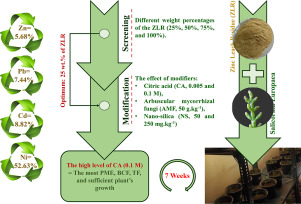当前位置:
X-MOL 学术
›
Ecol. Eng.
›
论文详情
Our official English website, www.x-mol.net, welcomes your feedback! (Note: you will need to create a separate account there.)
Phyto-extraction of zinc, lead, nickel, and cadmium from zinc leach residue by a halophyte: Salicornia europaea
Ecological Engineering ( IF 3.8 ) Pub Date : 2020-04-01 , DOI: 10.1016/j.ecoleng.2020.105797 Misagh Khanlarian , Melina Roshanfar , Fereshteh Rashchi , Babak Motesharezadeh
Ecological Engineering ( IF 3.8 ) Pub Date : 2020-04-01 , DOI: 10.1016/j.ecoleng.2020.105797 Misagh Khanlarian , Melina Roshanfar , Fereshteh Rashchi , Babak Motesharezadeh

|
Abstract The aim of the present study is to phyto-extract zinc, lead, nickel, and cadmium from zinc leach residue (ZLR)—as a metallurgical waste—by using Salicornia europaea plants. This study tried to introduce a new approach—which was common for remediation of contaminated soil and water—in order to recover and remove heavy metals from ZLR, which can provide more environmental sustainability as compared to conventional pyrometallurgical and hydrometallurgical processes. The experiments were performed at two stages (screening and modification). Due to high heavy metal concentrations and salinity of ZLR, at the screening stage, the ZLR/soil ratio was investigated and determined to be 25 wt% ZLR + 75 wt% soil, providing sufficient plant growth and heavy metal uptake. At this ratio, the BCF results were obtained 0.1, 0.12, 0.99, and 0.14 for zinc, lead, nickel and cadmium, respectively. At the modification stage, to enhance metal bio-availability and plant growth, the effects of three modifiers—citric acid (0.005 & 0.1 M), arbuscular mycorrhizal fungi (AMF) (50 g/kg), and nano-silica (50 & 250 mg/kg)—were investigated on the ZLR/soil optimum ratio. The results have revealed that AMF achieved the most plant growth. The plants treated by nano-silica accumulated metals in the root and did not translocate them from root to shoot. However, the optimum condition was treating the mixture containing 25 wt% ZLR by the high level citric acid (0.1 M), providing the most extraction, translocation factor, and sufficient plant growth. The result revealed that the BCFs of zinc, lead, nickel, and cadmium were obtained 0.23, 0.3, 2.11, and 0.35, respectively. Also, the TFs of zinc, lead, nickel, and cadmium reached to 1.04, 1.14, 3.5, and 1.1, respectively. At this optimum condition, 5.68% zinc, 7.44% lead, 52.63% nickel, and 8.82% cadmium were extracted. Therefore, in the pot containing 25 wt% ZLR, by applying 0.1 M citric acid, the most percentage of phyto-extraction was achieved.
中文翻译:

盐生植物从锌浸出渣中提取锌、铅、镍和镉:Salicornia europaea
摘要 本研究的目的是通过使用 Salicornia europaea 植物从作为冶金废物的锌浸出渣 (ZLR) 中植物提取锌、铅、镍和镉。本研究试图引入一种新方法——这是修复受污染土壤和水的常见方法——以从 ZLR 中回收和去除重金属,与传统的火法冶金和湿法冶金工艺相比,它可以提供更多的环境可持续性。实验分两个阶段进行(筛选和修改)。由于 ZLR 的重金属浓度和盐度较高,在筛选阶段,对 ZLR/土壤比进行了调查,确定为 25 wt% ZLR + 75 wt% 土壤,为植物生长和重金属吸收提供了充足的条件。在这个比例下,锌的 BCF 结果分别为 0.1、0.12、0.99 和 0.14,分别是铅、镍和镉。在改性阶段,为了提高金属的生物有效性和植物生长,三种改性剂——柠檬酸(0.005 & 0.1 M)、丛枝菌根真菌(AMF)(50 g/kg)和纳米二氧化硅(50 & 250 毫克/千克)——研究了 ZLR/土壤最佳比例。结果表明,AMF 实现了最多的植物生长。用纳米二氧化硅处理的植物在根部积累金属,并没有将它们从根部转移到地上部。然而,最佳条件是用高浓度柠檬酸 (0.1 M) 处理含有 25 wt% ZLR 的混合物,提供最多的提取、易位因子和足够的植物生长。结果表明,锌、铅、镍和镉的 BCF 分别为 0.23、0.3、2.11 和 0.35。此外,锌、铅、镍的 TF,和镉分别达到 1.04、1.14、3.5 和 1.1。在此最佳条件下,提取出 5.68% 的锌、7.44% 的铅、52.63% 的镍和 8.82% 的镉。因此,在含有 25 wt% ZLR 的锅中,通过应用 0.1 M 柠檬酸,实现了最大百分比的植物提取。
更新日期:2020-04-01
中文翻译:

盐生植物从锌浸出渣中提取锌、铅、镍和镉:Salicornia europaea
摘要 本研究的目的是通过使用 Salicornia europaea 植物从作为冶金废物的锌浸出渣 (ZLR) 中植物提取锌、铅、镍和镉。本研究试图引入一种新方法——这是修复受污染土壤和水的常见方法——以从 ZLR 中回收和去除重金属,与传统的火法冶金和湿法冶金工艺相比,它可以提供更多的环境可持续性。实验分两个阶段进行(筛选和修改)。由于 ZLR 的重金属浓度和盐度较高,在筛选阶段,对 ZLR/土壤比进行了调查,确定为 25 wt% ZLR + 75 wt% 土壤,为植物生长和重金属吸收提供了充足的条件。在这个比例下,锌的 BCF 结果分别为 0.1、0.12、0.99 和 0.14,分别是铅、镍和镉。在改性阶段,为了提高金属的生物有效性和植物生长,三种改性剂——柠檬酸(0.005 & 0.1 M)、丛枝菌根真菌(AMF)(50 g/kg)和纳米二氧化硅(50 & 250 毫克/千克)——研究了 ZLR/土壤最佳比例。结果表明,AMF 实现了最多的植物生长。用纳米二氧化硅处理的植物在根部积累金属,并没有将它们从根部转移到地上部。然而,最佳条件是用高浓度柠檬酸 (0.1 M) 处理含有 25 wt% ZLR 的混合物,提供最多的提取、易位因子和足够的植物生长。结果表明,锌、铅、镍和镉的 BCF 分别为 0.23、0.3、2.11 和 0.35。此外,锌、铅、镍的 TF,和镉分别达到 1.04、1.14、3.5 和 1.1。在此最佳条件下,提取出 5.68% 的锌、7.44% 的铅、52.63% 的镍和 8.82% 的镉。因此,在含有 25 wt% ZLR 的锅中,通过应用 0.1 M 柠檬酸,实现了最大百分比的植物提取。



























 京公网安备 11010802027423号
京公网安备 11010802027423号